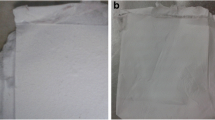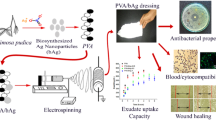Abstract
In this study, electrospun polycaprolactone membrane coated with chitosan-silver nanoparticles (CsAg), electrospun polycaprolactone/chitosan/Ag nanoparticles, was fabricated by immersing the plasma-treated electrospun polycaprolactone membrane in the CsAg gel. The plasma modification of electrospun polycaprolactone membrane prior to CsAg coating was tested by methylene blue stain and scanning electron microscope. The presence of silver and chitosan on the plasma-treated electrospun polycaprolactone membrane was confirmed by energy-dispersive X-ray spectroscopy and FT-IR spectrum. Scanning electron microscope observation was employed to observe the morphology of the membranes. The release of Ag ions from electrospun polycaprolactone/chitosan/Ag nanoparticles membrane was tested using atomic absorption spectrometry. Electrospun polycaprolactone/chitosan/Ag nanoparticles membrane inherited advantages from both CsAg gel and electrospun polycaprolactone membrane such as: increasing biocompatibility, mechanical strength, and antibacterial activity against both Gram-negative and Gram-positive bacteria. Thus, this investigation introduces a highly potential membrane that can increase the efficacy of the wound dressing process.











Similar content being viewed by others
References
Branco da Cunha C, et al. Influence of the stiffness of three-dimensional alginate/collagen-I interpenetrating networks on fibroblast biology. Biomaterials. 2014;35(32):8927–36.
Boateng JS, et al. Wound healing dressings and drug delivery systems: a review. J Pharm Sci. 2008;97(8):2892–923.
Liao N, et al. Electrospun bioactive poly (ɛ-caprolactone)–cellulose acetate–dextran antibacterial composite mats for wound dressing applications. Colloid Surface A. 2015;469:194–201.
Chitrattha S, Phaechamud T. Porous poly(dl-lactic acid) matrix film with antimicrobial activities for wound dressing application. Mat Sci Eng C. 2016;58:1122–30.
Liu S-J, et al. Electrospun PLGA/collagen nanofibrous membrane as early-stage wound dressing. J Memb Sci. 2010;355(1–2):53–9.
Kevadiya BD, et al. Biodegradable gelatin–ciprofloxacin–montmorillonite composite hydrogels for controlled drug release and wound dressing application. Colloids Surf B. 2014;122:175–83.
Duan K, et al. One-step synthesis of amino-reserved chitosan-graft-polycaprolactone as a promising substance of biomaterial. Carbohydr Polym. 2010;80(2):498–503.
Nguyen T-H, Lee K-H, Lee B-T. Fabrication of Ag nanoparticles dispersed in PVA nanowire mats by microwave irradiation and electro-spinning. Mat Sci Eng C. 2010;30(7):944–50.
Tran PA, Hocking DM, O’Connor AJ. In situ formation of antimicrobial silver nanoparticles and the impregnation of hydrophobic polycaprolactone matrix for antimicrobial medical device applications. Mat Sci Eng C. 2015;47:63–9.
Nguyen TH, et al. Nano Ag loaded PVA nano-fibrous mats for skin applications. J Biomed Mater Res B Appl Biomater. 2011;96(2):225–33.
Goy RC, Britto Dd, Assis OBG. A review of the antimicrobial activity of chitosan. Polímeros. 2009;19:241–47.
Abdelgawad AM, Hudson SM, Rojas OJ. Antimicrobial wound dressing nanofiber mats from multicomponent (chitosan/silver-NPs/polyvinyl alcohol) systems. Carbohydr Polym. 2014;100(0):166–78.
Akmaz S, et al. The effect of Ag content of the chitosan-silver nanoparticle composite Material on the Structure and antibacterial activity. Adv Mater Sci Eng. 2013;2013:6.
Sámano-Valencia, et al. Characterization and biocompatibility of chitosan gels with silver and gold nanoparticles. J Nanomater. 2014. 2014: 11.
Ojeda-Martínez ML, et al., Skin wound healing with chitosan thin films containing supported silver nanospheres. J Bioact Compat Polym, 2015;30:6617–632.
Nguyen TH, et al. A hybrid electrospun PU/PCL scaffold satisfied the requirements of blood vessel prosthesis in terms of mechanical properties, pore size, and biocompatibility. J Biomater Sci Polym Ed. 2013;24(14):1692–706. doi:10.1080/09205063.2013.792642 Epub 2013 Apr 29
Wu X, et al. The release properties of silver ions from Ag-nHA/TiO2/PA66 antimicrobial composite scaffolds. Biomed Mater. 2010;5(4):044105.
Croisier F, et al. Polysaccharide-coated PCL nanofibers for wound dressing applications. Adv Healthc Mater. 2014;3(12):2032–9.
Song W, et al. Coaxial PCL/PVA electrospun nanofibers: osseointegration enhancer and controlled drug release device. Biofabrication. 2013;5(3):035006.
Gautam S, et al. Surface modification of nanofibrous polycaprolactone/gelatin composite scaffold by collagen type I grafting for skin tissue engineering. Mater Sci Eng C. 2014;34:402–9.
Martins A, et al. Surface modification of electrospun polycaprolactone nanofiber meshes by plasma treatment to enhance biological performance. Small 2009;5(10):1195–206.
Mohiti-Asli M, Pourdeyhimi B, Loboa EG. Novel, silver-ion-releasing nanofibrous scaffolds exhibit excellent antibacterial efficacy without the use of silver nanoparticles. Acta Biomater. 2014;10(5):2096–104.
Nguyen, T.T.C., et al. Highly lipophilic pluronics-conjugated polyamidoamine dendrimer nanocarriers as potential delivery system for hydrophobic drugs. Mater Sci Eng C.
Hoang Phuc D, et al. Fabrication of hyaluronan-poly(vinylphosphonic acid)-chitosan hydrogel for wound healing application. Int J Polym Sc. 2016;2016:9
Gautam S, et al. Fabrication and characterization of PCL/gelatin/chitosan ternary nanofibrous composite scaffold for tissue engineering applications. J Mater Sci. 2014;49(3):1076–89.
Zhu Y, Gao C, Shen J. Surface modification of polycaprolactone with poly(methacrylic acid) and gelatin covalent immobilization for promoting its cytocompatibility. Biomaterials. 2002;23(24):4889–95.
Lischer S, et al. Antibacterial burst-release from minimal Ag-containing plasma polymer coatings. J R Soc Interface. 2011;8(60):1019–30.
Yohe ST, et al. 3D superhydrophobic electrospun meshes as reinforcement materials for sustained local drug delivery against colorectal cancer cells. J Control Release. 2012;162(1):92–101.
Chu PK. Enhancement of surface properties of biomaterials using plasma-based technologies. SurfCoat Tech. 2007;201(19–20):8076–82.
Fayaz AM, et al. Biogenic synthesis of silver nanoparticles and their synergistic effect with antibiotics: a study against gram-positive and gram-negative bacteria. Nanomedicine. 2010;6(1):103–9.
Nguyen T-H, Lee B-T. In vitro and in vivo studies of rhBMP2-coated PS/PCL fibrous scaffolds for bone regeneration. J Biomed Mater Res A. 2013;101A(3):797–808.
Zaman HU, et al. Physico-mechanical properties of wound dressing material and its biomedical application. J Mech Behav Biomed Mater. 2011;4(7):1369–75.
Shevchenko RV, James SL, James SE. A review of tissue-engineered skin bioconstructs available for skin reconstruction. J R Soc Interface. 2010;7(43):229–58.
Rigo C, et al. Active silver nanoparticles for wound healing. Int J Mol Sci. 2013;14(3):4817–40.
Fish DN. Meropenem in the treatment of complicated skin and soft tissue infections. Ther Clin Risk Manag. 2006;2(4):401–15.
Riss TL, Moravec RA, Niles AL, Duellman S, Benink H, Worzella TJ, Minor L. Cell Viability Assays. In: Sittampalam GS, Coussens NP, Nelson H, et al., editors. Assay Guidance Manual. Eli Lilly & Company and the National Center for Advancing Translational Sciences; 2004.
Darby IA, et al. Fibroblasts and myofibroblasts in wound healing. Clin, Cosmet Invest Dermatol. 2014;7:301–11.
Svendsen MN, et al. Bacterial antigen induced release of soluble vascular endothelial growth factor (VEGF) and VEGFR1 before and after surgery. Scand J Clin Lab Invest. 2005;65(3):237–47.
Xue ML, Thakur A, Willcox M. Macrophage inflammatory protein-2 and vascular endothelial growth factor regulate corneal neovascularization induced by infection with Pseudomonas aeruginosa in mice. Immunol Cell Biol. 2002;80(4):323–7.
Acknowledgments
The work relative with the PCL electrospun membranes is funded by Office of Navy Research (ONR) under grant number: N62909-14-1-N011-P00001, PR No: N6290914PR00015/N00014. The work relative with chitosan-AgNPs gel is funded by Vietnam National University-Ho Chi Minh City under grant number: B2013-76-03.
Author information
Authors and Affiliations
Corresponding author
Ethics declarations
Conflict of interest
The authors declare that they have no competing interests.
Rights and permissions
About this article
Cite this article
Nhi, T.T., Khon, H.C., Hoai, N.T.T. et al. Fabrication of electrospun polycaprolactone coated withchitosan-silver nanoparticles membranes for wound dressing applications. J Mater Sci: Mater Med 27, 156 (2016). https://doi.org/10.1007/s10856-016-5768-4
Received:
Accepted:
Published:
DOI: https://doi.org/10.1007/s10856-016-5768-4




